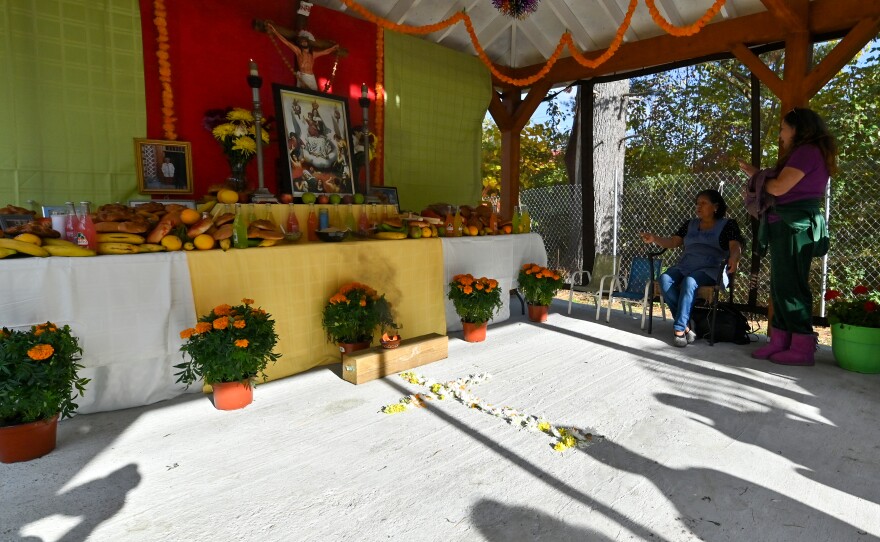Pinecones outline a path of pine needles and flowers. That’s the scene upon entering Claudia Casales and Armando Castros' yard. The path leads the dead to an ofrenda, or a home altar where offerings are placed, tucked in a tented patio. The ofrenda is an integral part of the celebration of Dia de los Muertos. It has three levels. The bottom is for food and offerings to the dead; the second is for photos of the departed; the top level reserved for Jesus and a crucifix.
The first day of Dia de los Muertos is typically Oct. 30. It is meant to remember those have who died in tragic ways. Locally, the Rosario en Familia prayer group celebrated on Oct. 28 so they could be together. Quirino Ponce places dozens of bananas, plantains, oranges and apples on the lowest level of the ofrenda. A candle is lit for each of the dead, whose photographs rest between the fruit, bottles of a local favorite soda Jarritos, beer and pan de muerto. As each pan de muerto is placed, the name of a family or friend that has passed is spoken. Quirino says the names of those who died in accidents or who were murdered while setting the bread down. Copal incense is used as well to lead the dead to the ofrenda.
The second day was celebrated on Oct. 31. It is meant for babies and children who have died. Nov. 1 is the day when all deceased are remembered. On the last day, Nov. 2, families visit the cemetery and light candles that remained on the ofrenda. The last day isn’t celebrated quite the same in the United States, because many families send their deceased back to Mexico for burial.
While Quirino carefully places the items on the ofrenda, his wife Eligia prepares mole, a traditional Mexican dish made with chiles and chocolate. The mole was a favorite of Claudia's father. Claudia was busy preparing pepian, a dish that uses ground pumpkin seeds. A new dish of each food is placed on the ofrenda each day. While others cook, Claudia's daughter, Rosa, 8, spreads flower petals and blooms in front of the ofrenda in the shape of a cross. Like her grandfather, Rosa’s favorite is the mole.
Once the food is prepared, members of the St. Nicholas prayer group, Rosario en Familia carry the mole, pipian and tamales to the ofrenda while singing. The group has a meal together before beginning songs, prayer and the rosary. As the sun was setting a group of 15 faithful stood before the ofrenda to pray for those that have passed. As the singing grew, curious children on bicycles stopped to take a peek at the activity.
The tradition is a way to remember those that have passed and to teach younger generations about their family. They say seeing the photographs gives them a visual to remember and the family can discuss why they leave certain items on the ofrenda. Many believe that souls stay in purgatory before going to heaven, and that the living can help them move on by prayer.























